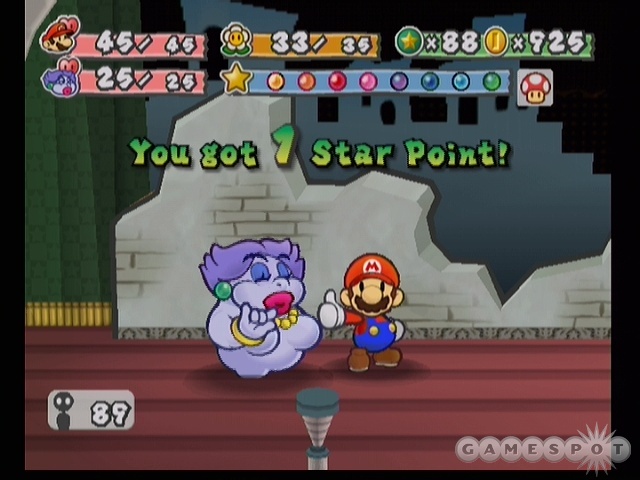Nintendo's unassuming little mustachioed mascot stars in one of his greatest adventures yet in Paper Mario: The Thousand-Year Door, which follows in the footsteps of last year's Mario and Luigi: Superstar Saga for the Game Boy Advance, as well as the original Paper Mario title for the Nintendo 64. This new role-playing game from Nintendo and developer Intelligent Systems is truly inspired. It's practically overflowing with wonderful, funny characters, memorable subplots, inventive gameplay, and beautiful visuals, and it's lengthy and quite challenging to boot.
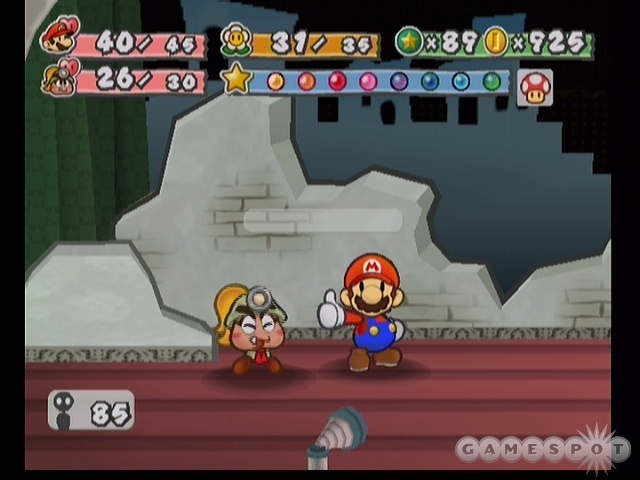
The adventure begins conventionally enough: Princess Peach has gone missing again, and it's up to Mario to find her. She was last seen in Rogueport, a seedy and mysterious coastal town far from the familiar reaches of the Mushroom Kingdom, and this place serves as the game's central location. Mario will gradually uncover Rogueport's secrets as he attempts to decipher a treasure map that Princess Peach left in his care. Soon enough, the quest develops a clear episodic structure involving the search for seven crystal stars, each one a powerful artifact. The stars are all tucked away in different parts of the world. So, in turn, the process of finding each one is like a unique and self-contained storyline in which Mario will meet some colorful new friends and foes and solve various puzzles using his ever-growing number of special abilities. That means Paper Mario is structured much like classic Mario games, in which each main level has a distinctively different tone and style to it.
While the overarching storyline is typical of a Mario game, the smaller subplots are what give Paper Mario: The Thousand-Year Door so much of its own charm and personality. It would be spoiling some of the fun to even briefly describe these various episodes, since each one provides a thrill of discovery, and the stark contrast from one episode to the next makes for a great experience. On the whole, the world of the game is brilliantly imagined and fully realized: It's filled with just about all the weird characters you may have seen in past Mario games, and yet here they're mostly just going about their day-to-day business, trying to make ends meet. The effect is reminiscent of Pixar's computer-animated movies (such as A Bug's Life or Finding Nemo), whose fantastic storybook worlds are believable partly because, in a lot of ways, they're mundane--not so different from real life. That's exactly the effect that Paper Mario goes for, and it's hugely successful at achieving it.
The game has a terrific sense of humor, thanks partly to a first-rate English translation. Much of the absurd humor comes from how Mario is one of the only human characters in the game, and yet his constantly bright-eyed, cheerful, but nearly silent demeanor makes him the most enigmatic character of them all. There's also a great deal of comedy to be found in between the game's chapters, as Bowser, Mario's nemesis, haplessly follows in the footsteps of his foe...yet is always several steps behind him. Also, Mario's brother Luigi makes an excellent appearance. In each chapter, he'll fill you in on the latest of his own eerily familiar-sounding misadventures. The game's sense of humor has truly broad appeal--younger audiences will love the funny-looking, over-the-top characters, while older players will appreciate some of the subtler wordplay and absurdity. You'd never know this game originated in Japan, since the always-amusing, often-funny dialogue just feels so contemporary and reads so naturally. There's no speech in Paper Mario: The Thousand-Year Door, but that's actually a good thing--the onscreen text unfolds dynamically, based on the intended tempo of the conversation, and it's generally so well written that it's just better off in its original written form. Indeed, most every character has a distinctive "voice" here, despite the absence of speech. If you've enjoyed the excellent localizations in other Nintendo games, such as Animal Crossing, The Legend of Zelda: The Wind Waker, or Mario and Luigi: Superstar Saga, then you can expect similarly outstanding results from Paper Mario.
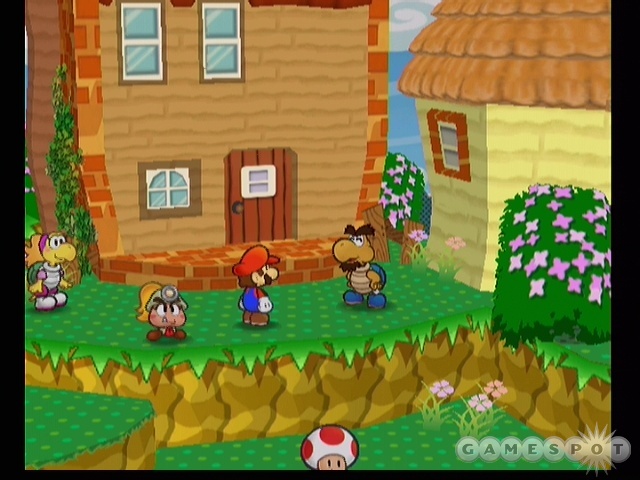
Paper Mario really isn't directly comparable to too many other games, though it's basically designed like other console RPGs. Gameplay is spent exploring various environments, encountering and battling foes in a turn-based combat system, and gaining experience levels and new skills. Exploration occasionally involves Mario-style conventions of having to jump from platform to platform, find hidden switches or passageways, or navigate around certain hazards. These action-type sequences are handled well in the context of the game, and--much like the action-oriented aspects of the combat system--they help make the experience of playing the game engaging (not to mention similar to classic Mario titles), rather than too slow and passive as in some other RPGs.
The game's storybook look also paves the way for some unique play mechanics, in how Mario actually has paperlike properties in the game. It's a level of abstraction that works beautifully in this surreal setting. Basically, Mario will learn how to slip through narrow gaps and gratings, glide like a paper airplane, roll up into a tube, and more. These unique abilities--which he learns in some of the game's funnier moments--allow you to gradually gain access to new areas. You'll also upgrade your hammer and your shoes during the course of the game, opening up even more venues to explore in the process. The gradual "unlocking" of the world is done quite subtly, actually. You'll gain some surprising new ability and then start to notice parts of the world in which the ability could come in handy. Of course, some of these abilities aren't just for exploration--they're also good for beating the tar out of Paper Mario's dozens of different bad guys.
Combat is frequent during some portions of Paper Mario: The Thousand-Year Door, though, fortunately, there are no random battles like in other RPGs. You'll see your foes out in the field, and if they spot you, they'll try to close in to initiate combat. If you manage to hit them with your hammer or jump on them when they're close (a question of proper timing), you'll get a free hit as the fight begins. Fights are turn-based, and involve Mario and his companions--you can have just one ally with you in battle at a time--taking turns dishing out damage with one or more bad guys. Over the course of the game, Mario will gradually learn a wide variety of jumping and hammer attacks, as well as some other special moves. Attacking is not just a matter of selecting options from a menu, either. Each technique has some sort of control input that's required for you to pull off the technique. Most of these are easy, timing-based affairs that you'll master after just one or two attempts.
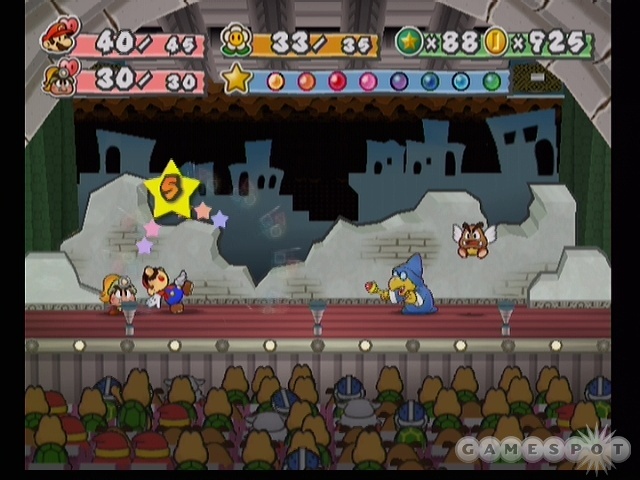
On the other hand, the timing for the game's defensive moves can be quite tricky. You can either press the A button just after getting hit to reduce the amount of damage you sustain, or, with perfect timing, you can press the B button as you get hit to nullify any damage and then counterattack. All enemy attacks can be countered, so you'll always be trying to get the split-second timing down, and it's satisfying to succeed at this. Having to constantly time button presses helps make combat an active and entertaining aspect of the game. For the most part, there's a good, fast feel to the combat, and like other aspects of the game, if nothing else, it's just fun to watch.
This is partly because the combat is literally conducted onstage, before an audience. In another of the game's inspired ideas, the entirety of Paper Mario: The Thousand-Year Door is staged like a theatrical performance, and this is apparent when you enter and exit buildings (you'll literally see the set pieces fold away--the fourth wall breaks down so you can see inside) and especially in battle. Appealing to the audience lets you use certain special moves more frequently at the expense of one of your combat rounds, and, sometimes, a surly member of the audience will throw something at you or your opponent. The audience participation in Paper Mario's battles ultimately doesn't have a huge impact on the gameplay, but it's a really neat touch, especially in the way the audience--which consists of all the different types of characters you'll meet in the game, both friend and foe--grows in size the further you get into the game.
Paper Mario has some real depth to it, which makes it a great-playing game and not just a great story with some battles thrown in to slow you down. Whenever Mario levels up after defeating a certain number of opponents, you may choose to boost one of his main attributes. One of these is called "badge points," which determine how many special badges Mario can have equipped. There are dozens of different badges to be found in the game, and they do everything from granting new fighting moves, to bolstering your strength and defense, to increasing the likelihood of finding items after a foe is defeated, to changing the sounds Mario makes when he attacks, and so on. More-powerful badges require a greater number of badge points to equip, and you're free to mix and match and experiment as much as you like. Mario himself may not look like much, but make no mistake: This game offers as much of the sort of addictive, open-ended character building as any first-rate RPG. In fact, the benefits of leveling up tend to be much more gratifying in Paper Mario than in other RPGs.
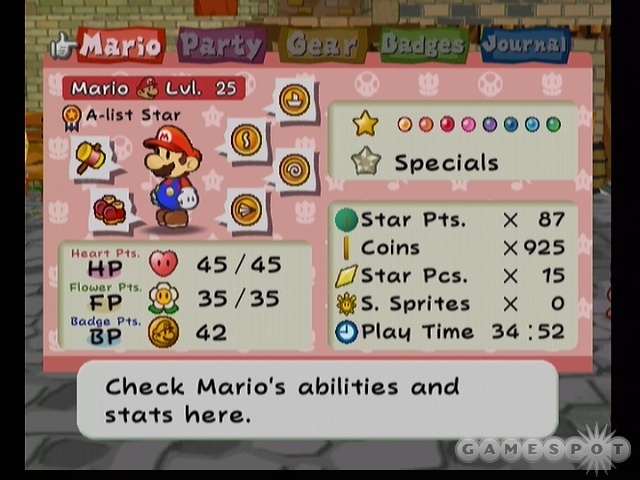
Furthermore, figuring out which of your allies will be best suited to a given situation is another interesting aspect of play. Each of Mario's friends has his or her own unique abilities both in and out of battle, and, in a contrivance that's great for the gameplay, you can freely switch between your companions almost instantly. These colorful characters are all quite valuable. For example, Goombella, a well-to-do goomba girl and Mario's first comrade, happens to know the local gossip on just about every character in the game. So, before striking up a conversation with somebody, you can always check with Goombella for the inside scoop--she'll tell you about the character in his or her own words. Likewise, she can look up valuable information on all the different foes you'll face, cluing you into their strengths and weaknesses. And she's just one of several interesting characters who'll join you.
Again, it's just not worth ruining the surprises to say much more about this aspect of the game. You'll also notice that Mario's partner--whether it's Goombella or someone else--tends to do a lot of talking, and will speak for Mario during conversations. However, since you can have only one partner with you at a given time, this means you'll inevitably miss a bunch of the potential exchanges of dialogue in the game if you play through only once. The fact that the dialogue changes depending on your traveling companion doesn't necessarily give a clear incentive to play through the Paper Mario a half dozen times, but it is another indicator of the game's unusually high quality.
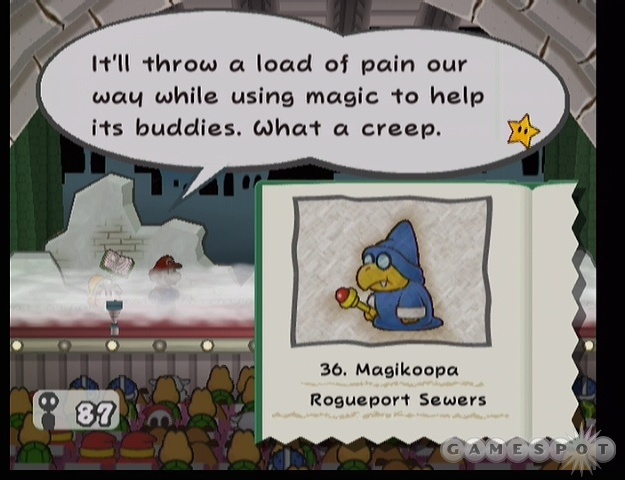
Paper Mario: The Thousand-Year Door is quite a long game, weighing in at 30 to 40 hours from start to finish. It's chock-full of optional side quests and secret areas, and also invites you to continue your adventures in and around Rogueport even after the main storyline reaches its satisfying conclusion. The game does have a few issues worth noting. Some combat-intensive sequences can get to be a little too repetitious at times, especially since there just isn't a ton of variety to the combat within a given area once you've figured out the best way to defeat a given type of foe. Furthermore, the game often requires you to go back and forth (and back and forth again) through areas you've already visited. This ultimately helps make the gameworld feel as big as it does, but within the moment, it can feel a bit like busywork. Considering how interesting most of Mario's adventures are here, the prospect of backtracking through the same areas several times isn't always so attractive. But the occasional hassle is, of course, well worth it. Finally--and this certainly isn't a flaw, but it should be noted for what it's worth--in case you haven't deduced this already, Paper Mario: The Thousand-Year Door is a surprisingly story-rich game. You might expect a Mario game to be focused mainly on action, but there's actually tons of character and plot development here. Save points are liberally interspersed throughout the game, so it's not like you're forced to play for long stretches at a time, but you'll naturally feel inclined to.
Paper Mario's outstanding presentation has a lot to do with how terrific of a game it is overall. It exhibits a level of visual artistry and technical prowess matched or exceeded by few other GameCube games, and, much like in last year's The Legend of Zelda: The Wind Waker, the unique graphical style on display throughout the game is constantly a joy to behold. The smoothly animated, hand-drawn characters who populate the game's world look far more like something you'd expect to see in a cartoon than something you'd expect to see in a video game. Also, the game's juxtaposition of flat 2D characters and certain other flat 2D elements amid pop-up-book-style 3D backgrounds not only adds to the visual flair, but it also sets up some interesting gameplay, as previously mentioned. At times, it even leads to some mind-bogglingly surreal moments, as when part of the screen literally peels away or tears open to reveal a secret area. The game also moves along at a consistently smooth clip, and there are no discernible loading times anywhere, except for maybe a couple of pauses here and there between major areas. At any rate, while Paper Mario's visuals may not seem like a technical tour de force, this is still one of the best-looking games of the year, and it's proof positive that high polygon counts and fancy graphical effects clearly aren't the only way to put together a superb-looking game.
The audio in Paper Mario fits the theme and tone of each sequence of the game very well. Certain characters have their own musical themes that become as recognizable as their appearances, and in general the music throughout the game is catchy and upbeat, much like the classic Mario music you may have heard. It's not all lighthearted stuff, either. Some of the game's spookier, creepier, or more emotional (yes, it's true) sequences also use sound and music to achieve their intended effect. Meanwhile, the sound effects in Paper Mario include some of the classics from the Mario series, along with plenty of other funny, appropriate-sounding audio bits.
If you've enjoyed any of Mario's past appearances, you really ought to give Paper Mario: The Thousand-Year Door a try. For that matter, you should try it even if you haven't. The game is clearly a labor of love, but it's a lot more than that--this is the product of some incredible talent in game design. It's difficult to imagine how someone could not be quickly pulled into Paper Mario's whimsical world if they give the game so much as half a chance to do its thing.
